A Look at The 5 Best Nikon FE Lenses
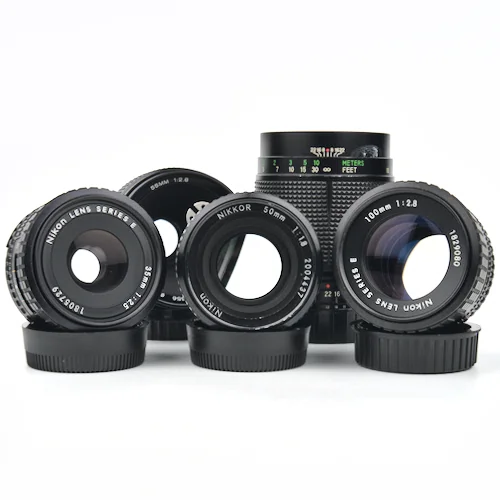
The Nikon FE needs a good lens to take sharp photos. We will go over the 5 best lenses for the Nikon FE. Alternative lens suggestions are included for different price points.
Best Lenses for the Nikon FE:
Affiliate Advertising Disclosure
Outside the Shot is a participant in the Amazon Services LLC Associates Program, an affiliate advertising program designed to provide a means for sites to earn advertising fees by advertising and linking to Amazon.com.
As an eBay Partner, I may be compensated if you make a purchase. I also participate in affiliate advertising programs with KEH and Adorama. More can be found on the Affiliate Discolsure page.
- Kit Lens - Nikon 50mm f/1.8 Series E
- Wide Angle Lens - Nikon Nikkor 24mm f/2.8 Ai
- Portrait Lens - Nikon 100mm f/2.8 Series E
- Zoom Lens - Vivitar Series 1 70-210mm f/3.5
- Macro Lens - Vivitar 90mm f/2.8
The top Nikon F-mount lenses are categorized by cost and type of photography. There are lots of outstanding lenses to choose from that are in price ranges suitable for the value of a FE.
Standard Prime Lens
The 50mm focal length lens is a superb choice for a vast array of photography. Such as street, everyday use, architecture, landscapes, portraits, and travel photography. It is the most common focal length that is used on the Nikon FE.
Nikon 50mm f/1.8 Series E
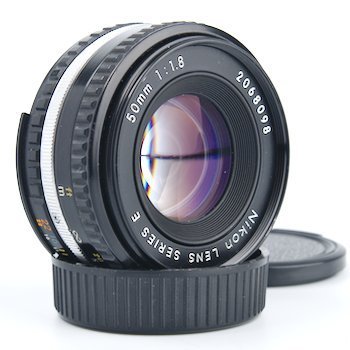
- One of the most popular 50mm lenses Nikon ever made.
- Excellent value.
- Light, small, and compact.
- 52mm filter threads.
See current price and more information on:
The Nikon 50mm f/1.8 Series E is one of the best lenses for the FE. This is because it is easy to find, has very good image quality, is affordable, compact, and lightweight.
Make sure to purchase the second version of the lens, which has a chrome ring around the body of the lens. It is made out of aluminum, whereas the first version has plastic parts.
The 50mm Series E lens is called a pancake lens because it is about as thick as a pancake. When mounted on the FE it will barely stick out. This is very handy for keeping the camera under a jacket to help you keep a low profile.
Nikon also produced several other 50mm manual focus lenses for the F-mount.
Nikon Nikkor 50mm f/1.4
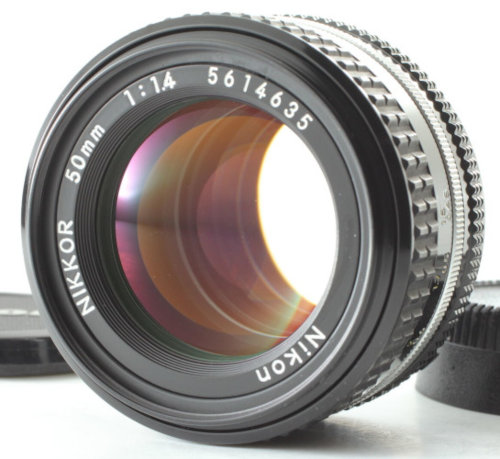
- Exceptional optics.
- Optical multi-coatings to improve output.
- Widely available.
- Relatively low-priced.
See current price and more information on:
The Nikon Nikkor 50mm f/1.4 is 2/3 of a stop faster, at the added cost of weight and size. It is slightly higher priced than all of the f/1.8 or f/2 50mm lenses.
Voigtländer Nokton 58mm f/1.4 SL II AI-S
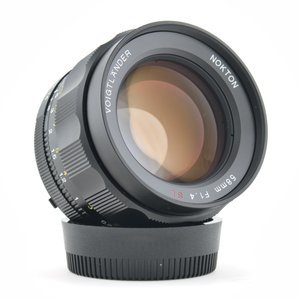
- Exceptional optics.
- Has a Meter Coupling Prong.
- CPU Contacts.
- Can be purchased new.
See current price and more information on:
Nikon manufactured a 50mm f/1.2 and 55mm f/1.2, but the value for money is bad. Due to the age of the lenses, you need to be concerned about the lubricant in the focusing helicoid drying up, ruining the experience of using the lens.
The Voightlander 58mm f/1.4 is all around a superior choice for a high-end lens. The lens has the smoothest focusing ring| I have ever used on a manual focus lens. It is a complete delight to use.
In addition, the lens maintains compatibility across all F-mount cameras. It has a Meter Coupling Prong, Ai Meter Coupling Ridge, CPU contacts, and has a switch to allow for electronic control of the aperture. You can move the lens from a Nikon DSLR to a Nikon 35mm film SLR seamlessly.
Alternative Standard Lenses
The following are several other good lenses that are comparable choices.
- Nikon Nikkor 50mm f/1.8
- Nikon Nikkor 50mm f/2
- Nikon 35mm f/2.5 Series E
- Nikon 28mm f/2.8 Series E
Wide Angle Lens
Nikon Nikkor 24mm f/2.8
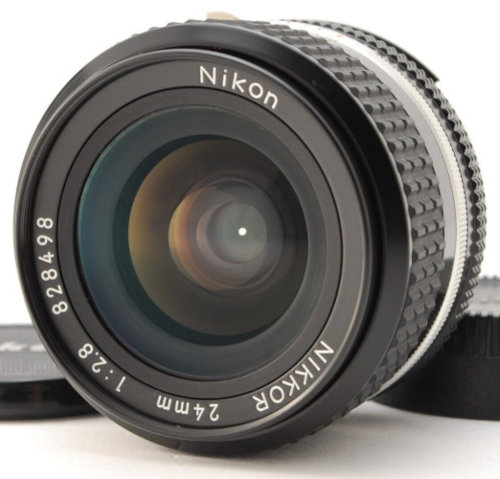
- Great combination with a 50mm lens.
- Optical multi-coatings to improve performance.
- Widely available.
- Relatively low-priced.
See current price and more information on:
A very good option for a wide-angle lens is the Nikon Nikkor 24mm f/2.8. The lens is ideal for architectural or landscape photography.
There are wider focal length lenses available. The problem is that they are either more expensive or have barrel distortion. Third-party lenses have clearly decreased image quality than Nikkor lenses.
Nikon 28mm f/2.8 Series E
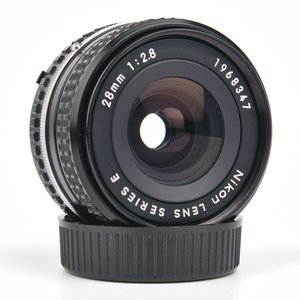
- Good when combined with a 50mm lens.
- Optical multi-coatings to improve output.
- Widely available.
- Inexpensive.
See current price and more information on:
The Nikon 28mm f/2.8 Series E lens is a less expensive alternative. It is attractive to use on the FE due to the low price and ease that the lens can be found.
Alternative Wide Angle Lenses
In terms of price, the correlation is straightforward. The greater the field of view, the pricier the lens will likely be. Larger apertures also sell for noticeably more.
- Nikon 8mm f/2.8 Fisheye
- Nikon Nikkor 15mm f/3.5
- Nikon Nikkon 18mm f/3.5
- Nikon Nikkon 24mm f/2
- Nikon Nikkon 13mm f/5.6
- Nikon Nikkon 16mm f/2.8 Fisheye
- Nikon Nikkon 20mm f/2.8
Portrait & Telephoto Lens
Nikon 100mm f/2.8 Series E Lens
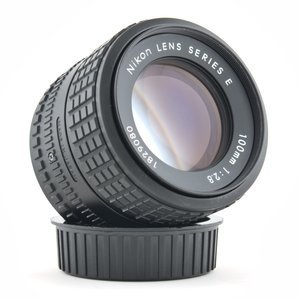
- 85mm alternative.
- Good value.
- Relatively inexpensive.
- Many copies are available.
See current price and more information on:
The 85mm focal length wasn’t as widely used as it is today in 1978 when the Nikon FE was first produced. 100mm or 135mm focal lengths were more commonly used thanks to their more affordable price.
Like all the other Series E lenses mentioned, the 100mm f/2.8 hits the right balance of performance, usability, and value. That’s why it was sought after when introduced and why numerous copies are readily available on the used market.
Nikon Nikkor 135mm f/2.8 Lens
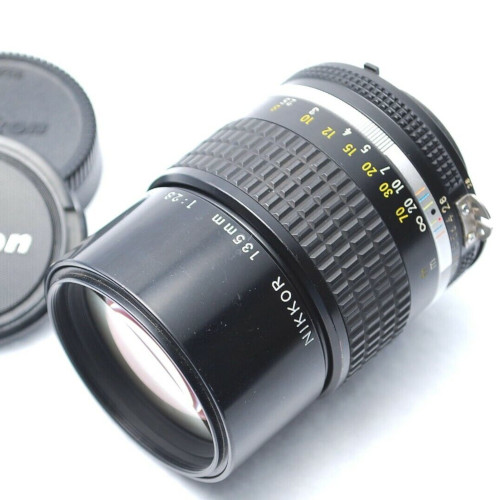
- 85mm alternative.
- "Vintage" portraiture rendering.
- Many copies are available.
See current price and more information on:
The “vintage” look of the Nikkor 135mm f2.8 comes from the focal length combined with the lens only containing 4 elements.
The first version of the lens was produced in 1965. A total of 6 versions of the lens, only the last two being suitable for the FE.
If you go to purchase a copy of the lens, the compatible versions will be listed as Ai or Ai-S.
Alternative Telephoto Lenses
There are plenty of additional telephoto lenses to select from. The 85mm lenses and focal lengths longer than 135mm will be highly-priced.
| Nikkor 85mm f/2 | Nikkor 105mm f/1.8 |
| Nikkor 105mm f/2.5 | Nikkor 135mm f/2 |
| Nikkor 135mm f/2.8 | Nikon 135mm f/2.8 Series E |
| Nikkor 180mm f/2.8 | Nikkor 200mm f/2 ED |
| Nikkor 300mm f/2 IF-ED | Nikkor 300mm f/2.8 |
| Nikkor 300mm f/4.5 | Nikkor 400mm f/2.8 IF-ED |
| Nikkor 500mm f/4 IF-ED P | Mirror Nikkor 500mm f/8 |
| Nikkor 600mm f/4 IF-ED | Nikkor 800mm f/5.6 IF-ED |
Nikon FE Zoom Lenses
In the early 1980’s, a few third-party lenses had incredible performance.
Many of these lenses would be released under the Vivitar brand name. Lenses that have the Vivitar Series 1 branding on them have terrific optics.
Vivitar Series 1 70-210mm f/3.5
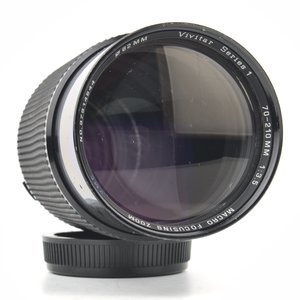
- Covers a popular zoom range.
- Good for portrait or wildlife photography.
- A rare example of when a third-party lens is the best.
See current price and more information on:
Alternative Zoom Lenses
There are not very many options for zooms for the Nikon FE that have a shorter focal length zoom range. Age along with wear and tear has resulted in many Nikon zooms to end up being essentially unusable.
The single zoom lens I would advise looking for is the Vivitar Series 1 VMC 35-85mm f/2.8 (Also found on KEH). , the lens can be challenging to find.
Vintage Zoom Lens Problems
The lens that could’ve been the best option, the Nikon Zoom-Nikkor 35-105mm f/3.5-4.5, is unfortunately, a push-pull zoom. Rather than having having a zoom ring, the entire focus ring is pushed or pulled to control the lens zoom range.
The grease in just about all of these lenses has broken down to where the zoom mechanism will not hold itself up. Because of this, the lens will have small changes in focal length when you try to focus. This will be made worse if the lens is not parallel to the ground.
Nikon Macro Lenses
Komine manufactured the two recommended macro lenses in Japan. The lenses were also released under various brand names. Elicar, Quantaray, Panagor, Spiratone, and Rokunar are brands that also released the lenses.
There is a Vivitar 90mm f/2.8 Macro Lens Review and a Vivitar 55mm f/2.8 Macro Lens Review.
For capturing images at 1x magnification, the 90mm lens will be the better choice since it has a larger working distance.
For table-top and close-up photography, the 55mm macro lens is the better choice.
Vivitar 90mm f/2.8
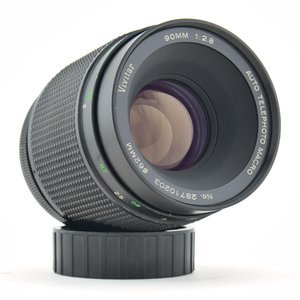
- The best vintage macro lens I've used.
- Available in multiple lens mounts.
- Incredible value.
See current price and more information on:
Vivitar 55mm f/2.8 Macro Lens
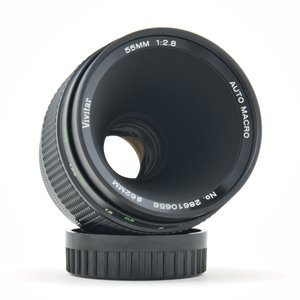
- The second best vintage macro lens I've used.
- A good lens for close-up photography.
- It doesn't need an extension tube to achieve life-size magnification.
See current price and more information on:
Alternative Macro Lenses
- Nikon Micro Nikkor 55mm f/3.5
- Lester A Dine 105mm f/2.8
- Micro Nikkor 105mm f/2.8
Used Nikon Camera Lens Prices
The prices of camera lenses change all the time depending on supply and interest in older lenses. During the last several years, film photography was going through an increase in interest, which has pushed prices higher.
Economic changes can quickly lead to large price changes. Having said that, the relative difference in prices between lenses should be expected to stay the same.
Checking several websites is the best way to get accurate pricing. If you come across a great deal, quickly buy it, because the best deals are short lived.
What Lens Mount Does the Nikon FE Use?
The Nikon FE uses the Nikon F lens mount. Released in 1959, the Nikon F-mount was discontinued in 2021. Changes were made to the mount over time to add features. These included autofocus coupling, CPU contacts, metering information, and electronic aperture control.
For the FE, you need to use lenses that are manual focus and are either Ai-S or Ai. The meter coupling ridge built into those lenses will allow the camera to correctly meter light.
For an explanation F-mount lenses, here is a page that explains Nikon F-mount lens and camera compatibility.
Standard Lens Cap Size
The standard filter ring thread and lens cap size for the majority of vintage manual focus F-mount lenses is 52mm. Bear in mind, lenses with large front elements are going to require larger filters and lens caps.
The benefit of having a standardized filter thread diameter is that you only have to have one set of lens filters.
Non Ai vs Ai & Ai-S Lenses
The early Nikon F-mount cameras had a Meter Coupling Prong. The Nikon FE uses a Meter Coupling Ridge.
A bunch of lenses contain both types of meter coupling as they were built around the time Nikon switched to Ai lenses.
Lenses that only have a Meter Coupling Prong will damage your FE if you attempt to put one on the camera.
More Nikon FE Resources
There is no more info on the best Nikon FE lenses. When more info is added to the site, links can be found here.